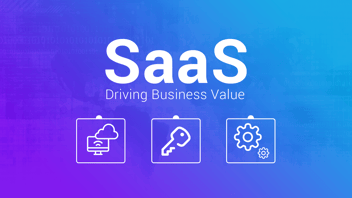Vertical SaaS - All you need to know
Software-as-a-Service (SaaS) has been on the rise throughout the last couple of decades and it’s nowhere near its peak. Launching a SaaS product in this scenario requires careful consideration of the markets and deciding which approach model to adapt to is an argument in itself. To better understand this, we will look at the two different cloud computing models within SaaS.
Venture Capitalists and vertical SaaS
How to build your next Vertical SaaS ideas
How can you leverage Undaku to create vertical SaaS solutions?
Horizontal vs Vertical SaaS
Horizontal SaaS companies target to engage with a wide group of customers regardless of any specific industry. Their products function across different domains like Customer Relationship Management (CRM) software and applications focused on sales, customer service, marketing automation, analytics, and application development et cetera. Salesforce is a behemoth figure that leans over horizontal SaaS and is also the first company to develop and optimize SaaS solutions for the world.
Vertical SaaS companies, on the other hand, are devoted to solving problems and bringing solutions to the niche market. They target specific customers and compete with highly specialized product features and pricing, satisfying specific market needs. Hence the competition in this segment is huge as there are numerous super companies delivering similar solutions.
Vertical SaaS examples
Vertical SaaS solutions do not attempt to solve all things, yet they tend to be a complete solution for a specific problem. There are many different industries that can benefit from vertical SaaS solutions. Some examples include:
- Healthcare: Electronic health records (EHRs), practice management, telemedicine, and patient engagement are some of the areas in which healthcare providers can use SaaS to improve patient care and streamline operations.
- Retail: Retail businesses can use SaaS for inventory management, point-of-sale systems, customer relationship management, and e-commerce platforms.
- Finance: Financial institutions can use SaaS for accounting, compliance, risk management, and back-office operations.
- Manufacturing: Manufacturing companies can use SaaS for enterprise resource planning (ERP), supply chain management, and predictive maintenance.
- Construction: Construction companies can use SaaS for project management, scheduling, and collaboration tools.
- Media and Entertainment: Media and Entertainment companies can use SaaS for digital asset management, video distribution, and content management systems.
Apart from these industries, there are vertical SaaS solutions available for many others, including education, government, legal, logistics and transportation, and more. The key is that the SaaS solution is tailored to the specific needs and requirements of the industry.
Vertical SaaS companies
Given below are just a few examples, there are many vertical SaaS companies addressing a wide range of industries like retail, construction, transportation, education, and more:
Meditech: A company that provides electronic health record (EHR) software for hospitals and clinics.
AppFolio: A company that provides property management software for landlords and property managers.
FieldAware: A company that provides field service management software for service-based businesses, such as HVAC and plumbing companies.
Salesforce Health Cloud: A company that provides a CRM platform to manage patient data and collaboration tools for healthcare providers.
SmartAdvocate: A company that provides case management software for legal professionals
Workday: A company that provides ERP software to manage human resources and financials for large organizations.
Venture capitalists and vertical SaaS
Venture capitalists (VCs) are bullish on vertical Software as a Service because it allows them to invest in companies that have a deep understanding of specific industries and target markets. These companies often have a unique value proposition that addresses the specific needs of their customers, which can lead to high customer retention and strong revenue growth. Additionally, the recurring revenue model of SaaS can provide a predictable and stable source of income for these companies, making them attractive investments for VCs. Furthermore, vertical SaaS companies can often command higher valuations and exit prices due to their niche focus and the specialized nature of their offerings.
Vertical SaaS: The Future
There are several reasons why vertical SaaS is becoming more popular and why it's considered the future of SaaS:
Industry-specific needs: Vertical SaaS solutions are built with the specific needs of an industry in mind, so they often include features and capabilities that are directly relevant to that industry. This makes them more useful and efficient for businesses operating within that industry.
Greater ease of use: Because vertical SaaS is built with a specific user base in mind, it is often more intuitive and user-friendly than horizontal SaaS, which must accommodate a wide range of users with different needs.
Improved performance: vertical SaaS providers can optimize the solution for a specific type of user, and industry which leads to more performant solutions.
Greater growth potential: As industries continue to digitize, the potential market for vertical SaaS solutions will continue to grow, allowing for greater revenue and market penetration for providers of these solutions.
More customization: In vertical SaaS, As the company is aware of the industry-specific requirement, they can provide more customization as per the requirement which is not usually possible in horizontal SaaS
Overall, vertical SaaS is considered to be the future of SaaS because it offers businesses more industry-specific capabilities, is more user-friendly, and has greater growth potential.
How to build your next Vertical SaaS ideas
Building a successful vertical SaaS company begins with identifying a specific market or industry that you are passionate about and that you believe has a real need for software solutions. Here are some steps you can take to build your next vertical SaaS idea:
1. Conduct market research: Start by researching the industry or market you're interested in. Identify the main pain points and challenges that businesses and professionals in that industry are facing. This can be done through online research, talking to industry experts, or surveying potential customers.
2. Identify a specific problem: Once you have a good understanding of the industry and its challenges, you can start to identify a specific problem that you believe you can solve with software. The more specific and well-defined the problem is, the better.
3. Validate your idea: Before you start building your software, you'll want to validate your idea to ensure that it has a real market. You can do this by talking to potential customers and gathering feedback on your concept.
4. Build a Minimum Viable Product (MVP): Once you have validated your idea, you can begin building an MVP, which is a basic version of your software that has enough features to satisfy early customers and get feedback for further development.
5. Test and iterate: Keep testing and gathering feedback, and iterate on your product, as you build it. Test it with users to measure the effectiveness of your product and take their feedback to improve your product.
6. Develop a business plan: Once you have a working MVP, you'll need to develop a solid business plan that outlines how you plan to generate revenue and scale the business.
7. Get funding: As you move forward with building your software and growing your business, you may need to raise funding from investors to help finance your operations.
Building a successful vertical SaaS company is challenging, but with a solid idea, good research, validating your idea, iterating and scaling it, a good business plan and a great team it can be a profitable venture.
How can you leverage Undaku to create vertical SaaS solutions?
Undaku is a robust no-code app development platform that enables users to simply drag-and-drop different functions and components to build highly scalable SaaS applications to solve for your vertical requirements. Non-tech founders and businesspeople can leverage this opportunity to Go-to-Market quickly building your own vertical SaaS app without having to hire a tech team, which is expensive on time and resources. Undaku helps us to build highly scalable SaaS products that support all kinds of tenancy models, multi-geo deployment, subscription management, and data isolation et cetera within weeks, without having to write a single line of code.
.png?width=3072&height=2073&name=MicrosoftTeams-image%20(12).png)


